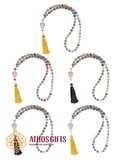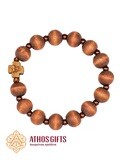The bracelet is handmade. It consists of small knots, into which two seed bead inserts are woven. The bracelet also contains a sterling silver icon depicting Saint George, which makes it not just a piece of jewelry, but a Christian symbol of faith. Thanks to a special braiding technique, the bracelet can be easily stretched by increasing the distance between the knots. This means it's is suitable for all wrist sizes.
Komboskini bracelets
Greek komboskini bracelets are woven by the monks of the Mount Athos monasteries with prayer and for prayer. The name of the bracelet reflects its essence and purpose: in Greek, kombos (κόμπος) means "knot", and skini (σχοινί) is a rope or cord.
The weaving of the komboskini bracelets is always accompanied by continuous prayer. Tying each knot, the monk says: "Lord Jesus Christ, have mercy on me." Due to this, Greeks believe that komboskini bracelet protects the person who wears it. But the bracelets also have a more practical use: like prayer ropes, they are used by the prayers to go through the knots and thus count the number of prayers uttered.
Bracelets are braided in a special way: each knot consists of 9 crosses of cord, symbolizing the nine crosses, or nine angelic ranks. Often seed beads, little crosses or icons are woven into the bracelet. Komboskini bracelets are usually worn on the wrist of the left hand, as it's closer to the heart. Believers often give such bracelets to their family and friends to remember and pray for them.
Saint George
George the Great Martyr is one of the most famous and revered saints of the Christian world. He lived at the end of the third and beginning of the fourth century. The son of wealthy and pious parents, St. George was brought up in the Christian faith. In his military career he was noted for his courage, intelligence and physical strength. He was also stately and handsome, and therefore soon won favor of the emperor Diocletian. The latter was a fierce opponent of Christianity, and in 303 began the persecution of Christians. Protesting against severe persecutions with all his heart, George gave away all his property to the poor, and then has appeared to Diocletian to openly declare himself a Christian.
The emperor unsuccessfully tried to persuade George to renounce his faith, after which he ordered to torture him. But no matter how fierce his tormentors were, George firmly endured all the trials and did not renounce Christ. Then Diocletian ordered to cut off the saint's head with a sword. Thus, in the year 303 at Nicodemia, George the Great Martyr was executed.
For his courage and firmness with which the saint endured trials, remaining faithful to Christ, and for his spiritual victory over his executioners, he is called Saint George the Victorious. Nowadays a part of the relics as well as the miraculous icon of Saint George are kept in the Xenophontos monastery on the Holy Mount Athos.
Prayer to Saint George
Almighty God, who gave to your servant George boldness to Confess the Name of our Savior Jesus Christ before the rulers of this world, and courage to die for this faith: Grant that we may always be ready to give a reason for the hope that is in us, and to suffer gladly for the sake of our Lord Jesus Christ; who lives and reigns with you and the Holy Spirit, one God, for ever and ever.
Characteristics
Length: 17, 18 or 19 cm
Weight: ~5 gr
Beads volume: ~5,5 mm
Material: weaving cord, seed beads, sterling silver
Similar Products
Light a candle
You can light a candle in the monasteries of St. Athos
Submit a note
Submit a memorial note to the monasteries of Athos
Mount Athos Shop
Handmade products by the monks of Holy Mount Athos
Transportation on Mount Athos
Book a vehicle for travelling on Holy Mountain
Diamonitirion
Obtain a visa to the Holy Mountain. Guarantee of issuance
Athos cruise
A tour along the west coast of the Holy Mountain on a cruise ship
Submit tamas
We will deliver your tamas to the icon of your choice




